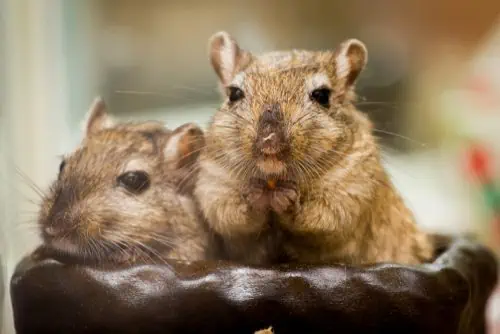
1. They’re tunnelling experts
In the wild, a colony of gerbils will typically construct an extensive network of burrows, with tunnels leading to food stores, nesting areas, and escape routes. These burrows can go as deep as 1.7 metres and stretch across 6-8 metres. The best way to mimic this natural habitat is to house them in a gerbilarium or aquarium with a secure wire lid and plenty of material for them to dig and tunnel into. Two gerbils need a minimum floor surface of 40cm x 75cm in a tank that’s at least 30cm tall because, as well as being great at digging, they’re also excellent jumpers.
2. They’re brilliant at gnawing
Because their teeth continue to grow throughout their lives, gerbils need to gnaw daily. In the wild, a gerbil will gnaw away at a branch of a pine tree, stripping off all the pines before moving on to the branch itself. Evidence that a group of gerbils are nearby can often be identified by gnaw marks on the wood in the area. Pet gerbils love chewing through cardboard tubes, but wooden gnawing toys provide a better long-term solution.
3. They’re fond of creature comforts
When they’re not being busy, these little animals enjoy a cosy nap in a nest box. Don’t choose wood or plastic, which they’ll chew – a better option is a clay flowerpot cut in half. To keep their coats clean and in good condition, a dust bath of chinchilla sand should be provided for them. They’ll also appreciate some fruit tree branches to climb on and, if you put a flat rock in the tank, it will become their all-important lookout point.
4. They’re insatiable hoarders
Whether they’re worried about supplies running low, or if it’s simply the case that such hardwired behaviour is impossible for even the best fed gerbils to shake off, these little rodents will hoard much more food than they need. They don’t have cheek pouches like hamsters but can carry food back and forth to their underground store very quickly to stock up, often working together to speed the process up. Gerbils are omnivores, which means that that protein is essential to their diet. Excel Hamster and Gerbil Food includes tasty mealworms and crickets that are rich in natural protein. Gerbils also enjoy small quantities of apple, carrot, broccoli, sprouts and cauliflower, served in earthenware or stainless steel bowls.
5. They’re superbly social
Although gerbils enjoy interacting with their human, they also need at least one gerbil buddy to be happy. Socialising, digging, hoarding and playing is much more fun as a duo, trio or gang. In the wild, gerbils build up their colony numbers by sticking together for many generations of offspring. Family groups can number as many as 17 or more, with many of the gerbils playing and helping each other on a daily basis.
6. They’re great parents
In the wild, young gerbils spend a lot of time with their parents, learning key life skills to enable them to survive and live healthily in the wild – they even pick up what they can or cannot eat from watching their parents and other family members. Gerbil dads are also involved in the upbringing of youngsters – they gather nesting materials to protect them, clean them, and show them how to gather food and materials for themselves. Gerbils can breed from three months old and can produce a litter of four to 10 babies every 24 days so, unless you want to be overrun by a dynasty of gerbils, it’s best to keep pairs or small groups of the same sex.
7. They’re good communicators
Gerbils don’t just use their hearing to communicate, they also have a highly tuned sense of smell. They mark their territory using their scent gland – and can tell if another gerbil has marked an area. Female gerbils mark their pups with their scent, which helps them recognise their own offspring and warn other gerbils away. Their long rear legs, which are not only brilliantly designed for fast digging, are also used to raise the alarm – if a gerbil senses danger they’ll thump their rear feet on the ground to warn the rest of the community.
8. They’re smart
While not as adaptable as rats when it comes to learning tricks from humans, gerbils can pick up some basic tricks. Using treats such as Excel Apple Snacks as a reward is a great way to get them to respond to what you are asking. When cleaning out their tank, place items back in different places. This helps stimulate your gerbils’ natural sense of curiosity, giving them a ‘new’ area to explore and keeping them happily active.
If you found this interesting, you may also like:
Bonding with your small pets: Hand-feeding is a great way to build a closer bond with small animals. It takes time to build trust, but when your little friend finally feels confident enough to take a treat from your hand, it’s a special moment.
Sources: bluecross.org.uk, rspca.org.uk














